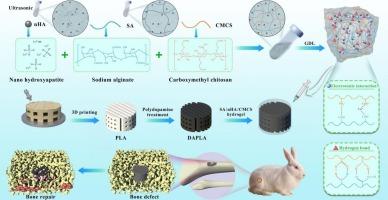用于骨缺损修复的羧甲基壳聚糖增强型多层次微结构复合水凝胶支架
IF 10.7
1区 化学
Q1 CHEMISTRY, APPLIED
引用次数: 0
摘要
临界骨缺损(CSBD)需要骨移植或组织工程支架等干预措施,以超越人体有限的自愈能力,确保有效的骨再生。为加强骨缺损修复,我们制作了一种多层次微结构复合水凝胶三维支架,将经过聚多巴胺处理的三维打印大孔聚乳酸(PLA)支架与海藻酸钠/纳米羟基磷灰石/羧甲基壳聚糖(SA/nHA/CMCS)微米级多孔复合水凝胶进行了整合。纳米羟基磷灰石(nHA)纳米颗粒的加入增强了水凝胶的交联和成骨活性。对 CMCS 浓度的系统评估表明,CMCS 在增强水凝胶交联和矿化、调节适应成骨周期的降解速率、赋予支架生物活性微米级多孔结构等方面起着关键作用。体外研究证实了复合水凝胶三维支架的成骨效果,尤其是含有 CMCS 的支架,能促进骨间充质干细胞(BMSCs)的粘附、增殖和分化。兔胫骨缺损模型进一步证实,与 DAPLA(多巴胺改性聚乳酸)支架相比,DSHC(DAPLA-SA/nHA/CMCS)支架的骨小梁数量增加了 2.06 倍。总之,该研究拓展了水凝胶支架在骨组织工程中的应用,为水凝胶植入材料的开发提供了有效策略。本文章由计算机程序翻译,如有差异,请以英文原文为准。

Carboxymethyl chitosan-enhanced multi-level microstructured composite hydrogel scaffolds for bone defect repair
Critical-sized bone defects (CSBDs) necessitate interventions like bone grafts or tissue engineering scaffolds to surpass the body's limited spontaneous healing capacity and ensure effective bone regeneration. A multi-level microstructured composite hydrogel 3D scaffold was fabricated for enhanced bone defect repair, integrating a 3D-printed macroporous polylactic acid (PLA) scaffold with polydopamine treatment and filled with a sodium alginate/nano hydroxyapatite/carboxymethyl chitosan (SA/nHA/CMCS) micrometer-scale porous composite hydrogel. The incorporation of nano hydroxyapatite (nHA) nanoparticles enhanced hydrogel crosslinking and osteogenic activity. A systematic evaluation of CMCS concentration demonstrated its pivotal role in enhancing hydrogel cross-linking and mineralization, regulating degradation rate adapted to the osteogenic cycle, endowing the scaffold with a bioactive micrometer-scale porous structure. In vitro studies confirmed the osteogenic effectiveness of the composite hydrogel 3D scaffold, particularly those with CMCS, which boosted bone mesenchymal stem cells (BMSCs) adhesion, proliferation, and differentiation. The rabbit tibial bone defect model further confirmed that, compared to the DAPLA (dopamine modified PLA) scaffold, the bone trabecular number of the DSHC (DAPLA-SA/nHA/CMCS) scaffold increases 2.06-fold. In conclusion, this study expanded the application of hydrogel scaffolds in bone tissue engineering and provided an effective strategy for the development of hydrogel implant materials.
求助全文
通过发布文献求助,成功后即可免费获取论文全文。
去求助
来源期刊

Carbohydrate Polymers
化学-高分子科学
CiteScore
22.40
自引率
8.00%
发文量
1286
审稿时长
47 days
期刊介绍:
Carbohydrate Polymers stands as a prominent journal in the glycoscience field, dedicated to exploring and harnessing the potential of polysaccharides with applications spanning bioenergy, bioplastics, biomaterials, biorefining, chemistry, drug delivery, food, health, nanotechnology, packaging, paper, pharmaceuticals, medicine, oil recovery, textiles, tissue engineering, wood, and various aspects of glycoscience.
The journal emphasizes the central role of well-characterized carbohydrate polymers, highlighting their significance as the primary focus rather than a peripheral topic. Each paper must prominently feature at least one named carbohydrate polymer, evident in both citation and title, with a commitment to innovative research that advances scientific knowledge.
 求助内容:
求助内容: 应助结果提醒方式:
应助结果提醒方式:


